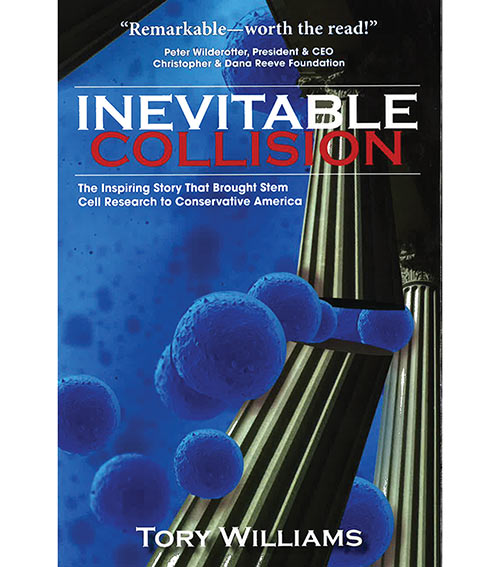Kevin Mayer Senor Editor Genetic Engineering & Biotechnology News
A new book, Inevitable Collision, gives readers an insider’s look at stem cell research advocacy.
When asked how to make news compelling, long-time 60 minutes producer Don Hewitt answered, “Tell me a story.” In other words, forget newspaper conventions, which emphasize facts and more facts, ordered from the most to the least important. Instead, feel free to mix facts with storytelling and somehow craft a narrative that has a discernible beginning, middle, and end. Be dramatic, even sensational. At the least, tell your stories though characters—people directly involved in whatever events you hope to relate—and resort only sparingly to observers, however knowledgeable.
Such a storytelling impulse, a willingness to personalize what could be presented as a highly impersonal sequence of developments, is much in evidence in a newly published book, Inevitable Collision, which provides an insider’s look at stem cell research advocacy. The book’s author, Tory Williams, begins by telling the stories of two key characters—Hans Keirstead, Ph.D., a stem cell researcher, and T.J. Atchison, a young man paralyzed from the chest down as the result of a car accident.
Dr. Keirstead, we learn, is the developer of a stem cell therapy that has been shown to repair spinal cord injuries in rats. This therapy, subsequently adapted to treat human patients, becomes the subject of a Phase I clinical trial. The trial, presided over by Geron, a biotech company, ends up enrolling T.J. Atchison.
Birth of a Stem Cell Research Advocate
These stories, however gripping, merely presage more elaborate developments in which the main protagonist is none other than Tory Williams, single mother, former elementary school teacher, magazine editor, aspiring writer, and—ultimately—stem cell research advocate.
While Williams lacks scientific or technical training, she clearly possesses curiosity and persistence. These qualities, along with an earnest sense of mission, help the author overcome her initial doubts that embryonic stem cells may be used without violating her ethical and religious convictions. What’s more, she becomes an energetic advocate, organizing fundraisers and networking with the likes of Roman Reed, who was instrumental in the passage of California’s Roman Reed Spinal Cord Injury Research Act.
Inspired by Roman Reed’s example, Williams encouraged the legislators in her home state of Alabama to pass the T.J. Atchison Spinal Cord Injury Research Act. Also, in collaboration with Roman Reed, Tory helped found the Alabama Institute of Medicine, a nonprofit dedicated to securing funding for the state’s stem cell researchers.
An impressive list of accomplishments, to be sure, but none of it would have been possible had Tory Williams not started by confronting her own (widely shared) doubts over the morality of using embryonic stem cells. This action, perhaps more than any other in the book, qualifies as an “inevitable collision.” Williams’ thoughts on this point are worth quoting at length:
“Now came the hard part: countering the objections that would surely be raised to this research. Most compelling among these was that the embryo used in this research was a human life and destroying it was the same as abortion or murder of the unborn.
“A preimplantation embryo is not a human life, but cells in a petri dish,” Williams continues. “This cluster of cells is destined to die unless it implants in the uterus to form a pregnancy. Indeed, it is estimated that 50 to 80 percent of these preimplantation embryos naturally formed in a woman’s body never implant and therefore die. A human life, as opposed to simply cellular life, begins, at the earliest, at or around day fourteen of human development. . . . Prior to day fourteen, the preimplantation of the embryo has no body cells of any kind. The embryo is not individualized.”
This line of thought may not impress those who care not at all about distinguishing between fertilization and conception—for example, those who object not only to the use of embryonic stem cells, but also to in vitro fertilization. Also, there are those who might find it objectionable to hear abortion equated with “murder of the unborn.”
Williams doesn’t address these constituencies. Instead, she focuses on the stem cell equivalent of swing voters. Also, in her lobbying of state officials, the risks of offending voters’ religious sensibilities are offset by the promise of economic development benefits. Every state, it seems, has ambitions of becoming a biotech version of Silicon Valley.
Telling Stories Faithful to the Facts
All in all, Williams presents a particular combination of idealism and practicality. Question it if you will, but if you do, consider who would chose to crusade on behalf of stem cell research, if not people like Williams. Like most people, Williams storifies. Even scientists storify, at least in their personal, social, and political lives, if not their scientific lives.
In Williams’ account, scientists are fairly remote figures. The scientists Williams encounters are friendly enough, but they’re content to stay in the background, offering the occasionally briefing and pep talk. This isn’t surprising, given that scientists are seldom prominent in politically sensitive discussions, even on topics that one would think impossible to discuss absent scientific input. Besides stem cell policy, such topics include climate change, information technology, and space exploration.
According to a review conducted by Princeton University's Woodrow Wilson School of Public and International Affairs and published online September 22 in the Proceedings of the National Academy of Sciences, Americans view scientists as competent but not entirely trustworthy. Perhaps scientists would be more trusted if they were more trusting, that is, if they were willing to engage in public debates more directly, if they were willing to communicate in ways that might actually touch ordinary people. One way, Williams demonstrates, is to tell stories that are faithful to the facts.







